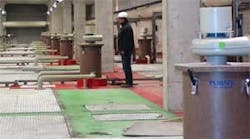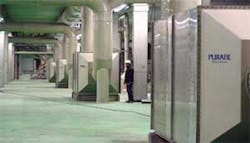Purafil ESD Eliminates Offensive Odors in Spain
Barcelona’s Besos Wastewater Treatment Plant turns to combination of dry–scrubbing media technologies to deal with hydrogen sulfide and ammonia problems.
By Shari Blalock
Located in northeastern Barcelona on the Mediterranean Sea, the recently renovated Besos Wastewater Treatment Plant (WWTP) is a revolutionary solution for more than two million people. The new 900,000 ft2, underground facility is the last stage in the city’s water cycle and now treats over 70% of the wastewater of Barcelona and surrounding towns: Sant Adria de Besos, Santa Coloma de Gramanet, Badalona, Montgat and Tiana.
A Smelly Problem
Barcelona, the capital of Catalonia, is the second largest city in Spain. With a thriving population, the city also has a bustling tourist industry. In fact, its 74–acre Forum, which is also on the Mediterranean just north of downtown, is a main attraction for residents and tourists alike. The Forum consists of plazas, parks, ports, luxury hotels, a concert arena, a convention center and a public square complete with an amusement park. While the population and tourist traffic in Barcelona have continued to grow to overwhelming proportions, odors from the cities’ increasing wastewater also grew. Specifically, odors from existing concentrations of hydrogen sulfide (H2S) and ammonia (NH3) in the wastewater were very prevalent. Both gases emit pungent, irritating smells if left untreated. To eliminate the poignant problem while maximizing on a visually pleasing atmosphere, the Ministry of Environment sought to enlarge and update the Besos WWTP. Due to the area’s growth spurt, space was limited. Therefore, the proposed solution for the necessary wastewater treatment plant was to construct the plant completely underground. The renovated Besos WWTP was constructed beneath the Barcelona Forum’s premium accommodations, which intensified the primary requirement for guaranteed odor control.
Providing the Solution
Purafil was suggested to provide odor control for the Besos WWTP because its products and equipment can be customized to specifically eliminate the prevalent gases emanating from wastewater, providing 100% odor removal. Initially, nearly 100 Purafil® ESD Drum–Scrubber odor control systems complete with Purafil OdoroxidantTM and OdormixTM dry–scrubbing media were selected to remove the odors and ventilate the densely populated area’s WWTP.
MediaSAKsTM containing the two dry–scrubbing media sit inside the Drum Scrubbers located at the Besos WWTP. Once the air enters the scrubbers, the odorous gases are trapped within the media and clean air is discharged out of the scrubbers’ centrifugal air ventilator.
Once the facility’s spacing and the end–user’s overall goal were reassessed, 16 Purafil Side Access (PSAs) units also were added to several rooms of the Besos WWTP. Although PSAs are typically used in either industrial or commercial environments, the systems’ versatile ability to remove both particulate and gaseous pollutants was the perfect addition to this project. The systems are individually engineered to the customers’ size parameters and to meet its specific odor needs.
Each PSA contains MediaPAK modules filled with the users’ choice of Purafil media for an engineered solution that will permanently eliminate the largest percentage of the odorous gases through chemisorption. The units are filled with various media to eliminate the gases specific to their location within the wastewater treatment plant. For instance, 0.2 ppm of H2S and 0.3 ppm of Mercaptans were detected at the plant’s inlet. To eliminate these, a PSA filled with Purafil Select and Purafil Select CP Blend media was used.
Conclusion
Eight months after the plant start–up, the engineering group that constructed the Besos WWTP was completely satisfied with the odor control Purafil provided to the heavily populated area. In fact, the firm placed an additional order for nine more odor control units for the extension of the plant.
The clean air solutions were ultimately successful in removing the odorous gases from the air. The dry–scrubbing media has demonstrated high performance against all kind of odors, and the technology has proven it’s possible to deodorize a huge plant, utilizing small airflows. In addition, Purafil has validated that it can provide a more flexible, efficient and cost–effective solution than other odor control technologies.
Author’s Note:
Shari Blalock is a communications specialist for Purafil
Inc., which is based in Doraville, Georgia, USA. Its Environmental Systems Division (Purafil ESD) manufactures a broad range of dry–chemical media and scrubbers that remove odors, prevent toxic gas releases, and prevent corrosion of electronics. Contact: 770–662–8545, [email protected] or www.purafil.com




